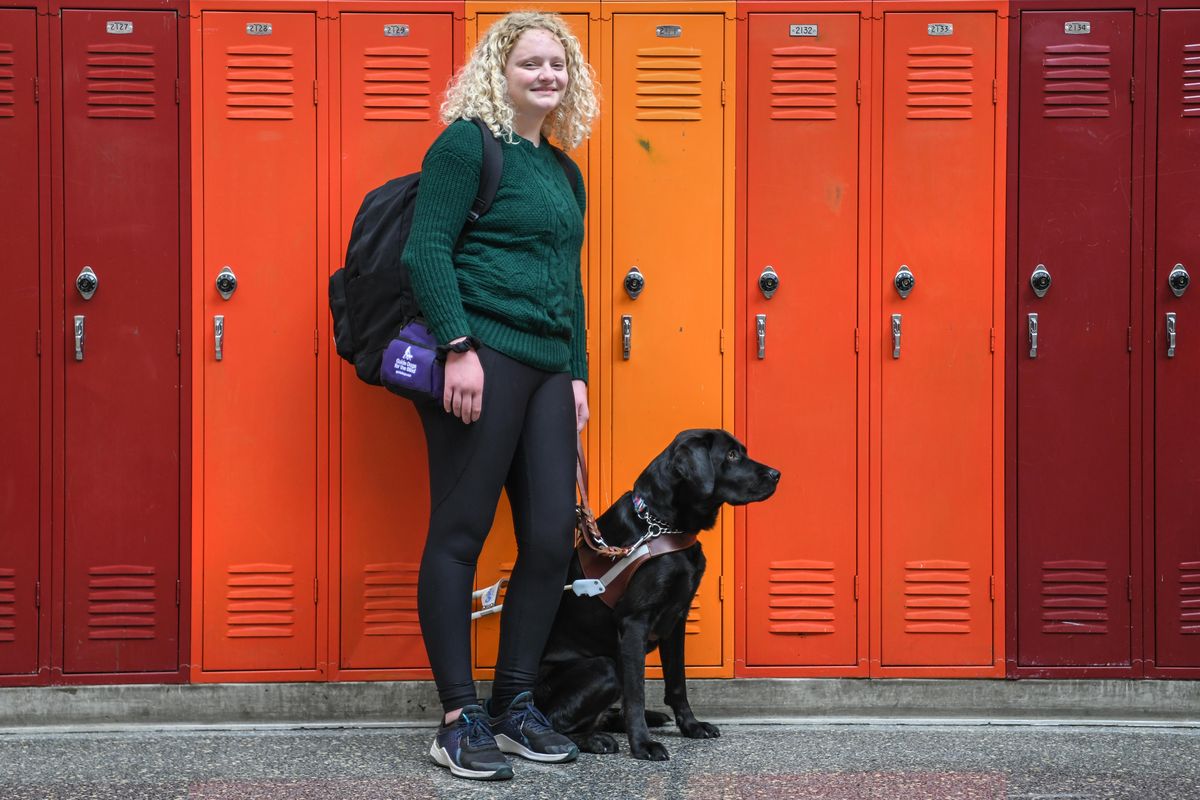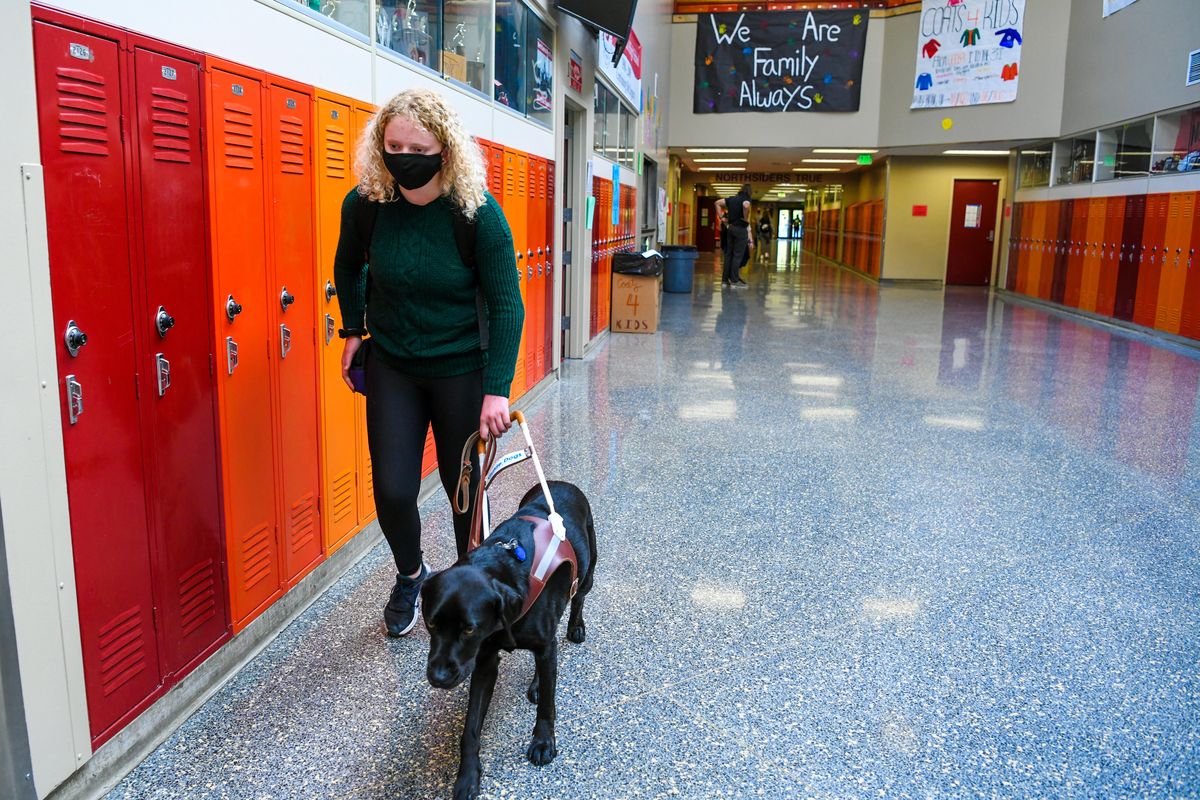Guiding the way: Legally blind teen finds navigating North Central High’s hallways easier, friendlier with canine Sable’s assistance
Alaina Gott, a 15-year-old at North Central High School, previously had to negotiate new boundaries with a white cane, but her guide dog Sable serves more than just a safe way to navigate a school hallway. Her dog also encourages friendly interactions and a sense of independence. "When people see a white cane, people tend to avoid you, but when they see a dog, they're more excited to talk about the dog and want to talk to you," Gott said. (Dan Pelle/The Spokesman-Review)Buy a print of this photo
Any student’s transition to high school can be an anxious time, with pandemic rules this year piling on more.
For Alaina Gott, 15, who is legally blind, she’s facing those challenges this fall at North Central High School with a new companion, Sable. Trained through Guide Dogs for the Blind, the 2-year-old female black Lab joined Gott’s side four months ago.
At school, Sable has offered a safer – and friendlier – way for Gott to navigate busy hallways. Sable’s brown eyes often remain fixed on Gott, unless she’s on task to get to a destination. She’s even trained to find a specific chair, which might be in a different place among various classrooms.
“Sable has been trained her whole life at Guide Dogs for the Blind,” said Gott, who lives in Spokane with her mom and three siblings. “I went to San Rafael, California, for the training. I’m one of their youngest clients.”
Gott was born with a condition called oculocutaneous albinism, or albinism Type 2. She can see colors and sometimes shapes. Her vision worsened during sixth grade when she started to use a white cane as a guidance tool. Gott said she’s now considered legally blind or vision-impaired.
“In the sun, I can’t see anything. Everything shakes because my eyes shake. I mostly read really large print, and I’m learning Braille right now. It’s really hard. I run track and field, and I can see well enough to see the white lines.”
After applying in February 2020, Gott learned she was accepted into the guide dog program in October 2020.
She received a home visit to evaluate the living environment, walking speed and Gott’s ability to orient her body “in time and space,” she said. “Because if you don’t know how to orient yourself and where you are in time and space, then you can’t get a guide dog because it’s not safe for you or the dog.”
She had researched life with a guide dog and knew it would be a better choice for her.
“I have a really busy lifestyle,” she said. “I’m a track athlete, go to school, and just having a guide dog is safer in general. Disabled women are twice as likely to be sexually assaulted. The guide dog can save you from getting hit by a car because they’ll see the car and pull you out of the way or refuse to cross the street.
“I almost got hit by a car because there was a Tesla. My sister was with me, and she saved me. I didn’t hear the car because it was an electric car, and it was really quiet, so I thought I really need to figure this out. I researched a lot about guide dogs and applied for one. It was free of charge, which was amazing.”
A recipient must pay for the basic continuing care and food of the dog, but she said Guide Dogs for the Blind helps pay for veterinary care.
The California trip involved two weeks’ training with Sable while Gott stayed in a campus dorm. They completed supervised training for basic commands, then customized training such as crossing a street, walking at night and navigating a city sidewalk with people around.
“They have to match you with the perfect dog,” Gott said. “I needed a dog good about going to school and walking my speed and not being afraid of cars. I needed a dog that’s super confident. I also needed her to be patient and calm when I’m practicing at track.”
Gott enjoys two sports, wrestling and track. She’s a sprinter year-round with the club organization ParaSport Spokane, and she’ll do track for the school in the spring. She also expects to wrestle for North Central.
“I do wrestling through the school. I’m the first female blind wrestler in Spokane Public Schools, which is pretty cool. I’m going to wrestle again, and the season will start soon in November.”
Since sixth grade, her vision issues haven’t changed much, but having a guide dog gives her more options.
A year ago, Gott didn’t go to school in-person during the first semester because of COVID-19 and then ended the year under a hybrid model at Chase Middle School. Before North Central started school, she went in a few weeks early to spend time in the afternoons to give herself and Sable time to learn their way around.
Later, she taught Sable what she calls “chair-targeting” with a command. It started with the use of a clicker to make sounds while training. The dogs are trained that if a handler makes a fist to place a nose on the hand. Gott went through a series of hand motions, clicker noises and treats with Sable, eventually leading to only a word command associated with the repeated action.
“Technically, it’s called back-chaining,” Gott said. “You keep doing that until they really start to get it and you don’t even need to put your hand out. They go right to the chair, and then you incorporate a word. For me, ‘Sable, chair.’ She’ll remember, ‘OK, that is a chair since you keep doing that.’ They’re so smart.”
Now, Sable knows the distinctions among Gott’s classrooms and where she sits.
Several weeks in, Sable also became more confident in the day’s school routine along with the directions to go. “She’s been slowly starting to memorize where everything is. She’ll offer to go left, I’ll be, ‘Oh yeah, good girl, we’re going left.’ Or it’s, ‘I know where we’re going.’ She’s a lot more confident.
“It’s so cool because when I used my white cane, I had to count every single classroom that I was going by, like five doors, then I take two lefts, one right, then go down the stairs, and it’s the second door on the left. But with Sable, it’ll be two lefts, one right, find the stairs and then find the door. She’ll do the rest. I don’t have to think as much.”
Most students are good about waiting to approach Sable, knowing the dog’s guiding, she said. Sometimes when seated or on breaks, Gott will take off the harness so Sable can relax or nap. Often, that’s when other students pet her.
Gott said it’s been tough to make friends when she can’t see people to approach them, but the dog has opened up more conversations.
“Now, I kind of have my little buddy,” she said. “I’ve met some people that way definitely.
“With a guide dog, it can be a good thing and bad thing socially. Sometimes, I want a nice walk that’s quiet. Other times, you want to meet people.”
Their overall routine works well. Gott will take Sable out at lunch for a bathroom break and water, then goes to have lunch in the library.
Sable can help her find other locations such as the water fountain, where Gott likes to fill a water bottle. “She always gets so excited when she finds it; she’ll start doing her little happy dance.”
A guide dog from the organization typically is in service for six to eight years, she said, then retired as a pet only. Sable shows excitement to get going each day, Gott said.
“She loves to work. She gets super excited when I get her harness out.
“I couldn’t imagine high school without her.”



